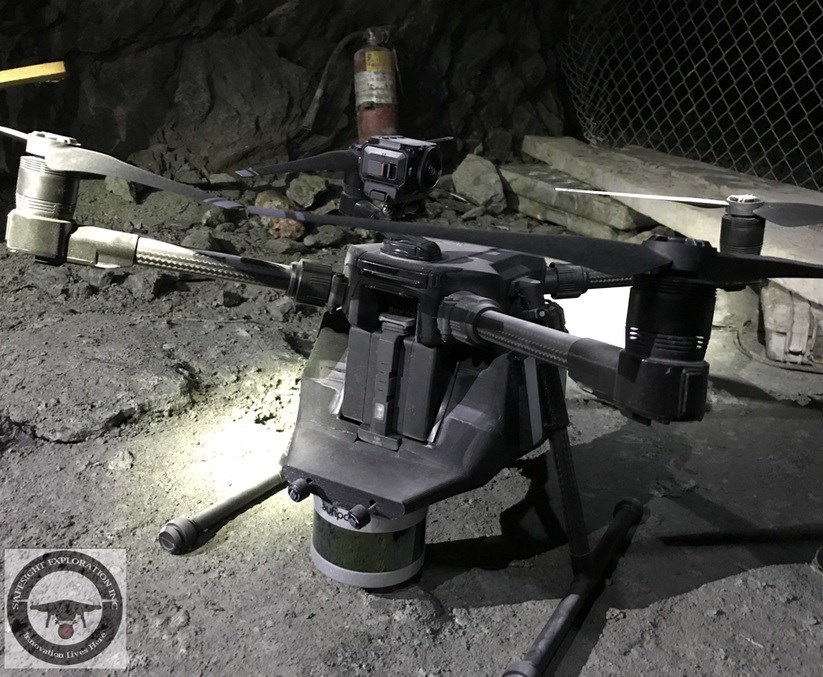A drone flies through a dark, treacherous mine tunnel. Blades whirring, the drone shines a light around the black rocks and relays what it sees across radio waves to its goggle-wearing pilot back in the safe zone.
It sounds like something out of a sci fi movie, but it’s just another day on the job for Lucas Tignanelli at SafeSight Exploration in North Bay, where they specialize in drone technology for mine sites.
That’s not to suggest flying a drone is easy, though.
“It’s a little intense, you’re flying $60,000 through a tight space,” said Tignanelli. “But I haven’t lost one yet!”
While Tignanelli is officially SafeSight’s product developer, due to its startup nature, he and the rest of the team often fill in where needed. Sometimes he’s flying drones, other times he’s working one-on-one with clients. As he says: “There are lots of holes that need filling.”
Not only is SafeSight a startup, it’s also a bit of a family business.
Tignanelli’s uncle, Mike Campigotto, formed SafeSight two and a half years ago, after he had supposedly retired.
“He had been a successful business owner in the past, and when he retired, he had heard about underground drones and how they could be beneficial to the mining sector,” explained Tignanelli. “He realized there were a couple people in town who already had a ton of experience, so he gathered this young group of entrepreneurs.”
Today, the team includes Campigotto and Tignanelli, along with a geologist, robotics lead, an unmanned aerial vehicle specialist, and an operations manager—several of whom are also family.
An elementary school music teacher by trade, the North Bay born-and-raised Tignanelli spent time teaching up North, but when he moved home, he wanted to try something a little different.
“When I came back I had an itch to get into business, and they had already started this company,” said Tignanelli. “There was a lot of dealing with people and event organization up North, and I guess I had a knack for working with people.
“I’ve always had an interest in technology and creating efficiencies, now I’m finding out what clients need and finding out how to make it quicker for them.”
SafeSight’s first product was the DB2, a rugged drone equipped with LiDAR (light detection and ranging) technology that can be used to create 3D models of a space by measuring reflected light.
Paired with the ability to control the drone remotely, the DB2 makes it possible to get into tight or dangerous spaces in mines, or potential mines, and map them out before sending real people in.
While other technologies exist to map out these sorts of spaces, SafeSight says their DB2 can complete a scan in half the time, and more accurately.
It’s not just the DB2 though. Some other products they’re developing include: a climbing robot that can place and detonate dynamite; a lightweight scouting drone that can precede the DB2 and its full LiDAR scan; and a rover, ground-based camera that crawls along tunnel floors rather than flying through.
While their technologies offer a wide range of benefits, Tignanelli said SafeSight is driven by a couple primary objectives.
“The two main benefits are safety, we can send in robots, we don’t have to send in humans and risk any injuries, and we also offer tonnage per day,” he said.
The faster a mine is mapped out and its hazards identified and dealt with, Tignanelli explained, the faster they can start producing.
At the moment, they have three DBRs, which they produced almost entirely out of 3D printed parts at their space on Trout Lake Road in North Bay. Everything else from the developing, coding, manufacturing, and marketing is all done in house, too.
When they can’t do something themselves, Canadore will often let them use their facilities, or they’ll reach out to other businesses to use their tools.
One company has purchased the product for themselves, and trained their surveyors on it, and Tignanelli said they’re using it nearly every day.
For other clients, they offer the scan as a same-day service.
“We’ll go to where they need a drift scanned, we’ll fly it for them, and give them the data that day,” said Tignanelli. “Then we’re out.”
At first, Tignanelli dealt mostly with the technical side of things, but now he’s dealing with clients as they branch out and grow. Recently, he started running service providing in the Timmins area.
The young company’s next steps will be at least partially based on that work; They’re nothing if not adaptable.
“I’m going up to Timmins every second week, using the product with them, training them,” said Tignanelli. “We’ll be making observational notes, bringing them back, and developing whatever the client thinks they need.”
All the while, Tignanelli is living many people’s childhood dream: playing with robots, for a living.
